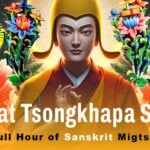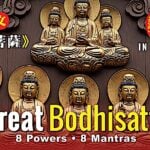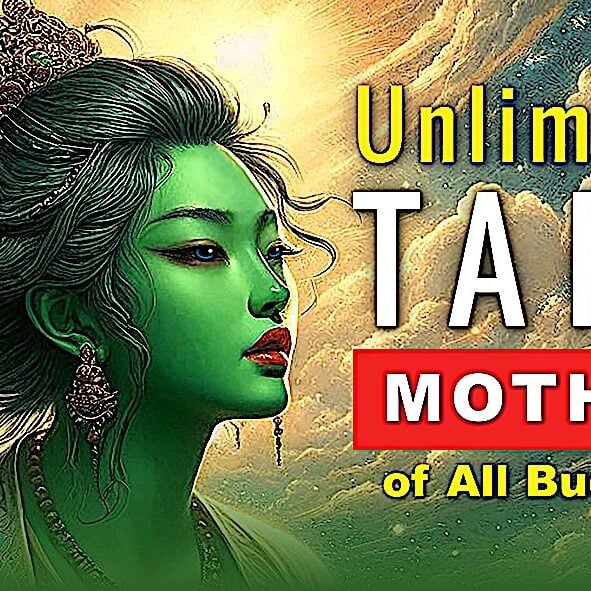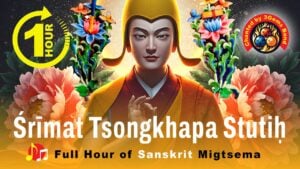21 Taras Short Dharani 108 Times: for Illness, Danger, Disaster, Wish-Granting, Averting War — All the Benefits of the Longer Dharani
Tara taught the concise version of the 21 Praises to Tara, as a healing and protection method to the great Lord Atisha. When his life was threatened by disease she appeared to him and told he would be completely cured if he recited the 21 Taras Dharani 10,000 times (the 21 Praises to Tara). However, he was so weak and desperate he asked for a condensed practice with equal result.
Tara gave him the short condensed essence Dharani — which today many use as the introductory four lines in many versions of the 21 Taras Praise. It is sometimes called the Praise to the Mantra — since it contains not only the essence of the heart mantra but also the heart of the entire 21 Praise Dharani. Enlightened Tara explained that the short four-line Dharani has the same effect as the entire 21 Tara’s Praise if chanted with complete faith.
Lord Atisha was able to recite the shorter praise 10,000 times and was cured. The concise praise is effective even if chanted 3 times, 7 times, 27 times or 108 times as a daily practice, especially in the original Sanskrit language (as presented here.) In times of urgent need — disease, disaster, danger or economic disaster, any circumstance shortening our life (and therefore our Dharma activities) — it is best to continue accumulating daily until you reach at least 1000, and for supremely difficult or mortal circumstances, 10,000 times. It is also a complete practice of Tara’s praise in a concise, easy-to-remember chant. As a lifetime commitment, it is considered supremely powerful to accumulate 1 million recitations.
The concise Dharani to the 21 Taras, also known as the Praise of the Mantra, is only four short lines. It is most effective when chanted in original Sanskrit, which we present here in our chant. (The translated Tibetan versions are available online, and the English version is below in this text.) Here, we chant the Concise Tara Praise Dharani 108 times. For people who are ill, or need protecton, of need fulfilment of wishes, it is recommended to chant at least 7 times, 21 times, 27 times, 108 times of 1008 times. In the case of Lord Atisha, who was in danger of his life, he chanted 10,000 times.
At the beginning of your session, you always chant the prostration praise to Tara once as we’ve done in this video. This is:
Om namo bhagavatyai
āryaśrī ekaviṃśati tārāyai
The concise mantra is:
namas tāre ture vīre
tuttāre bhayanāśini ture
sarvārthade tāre svāhā
kāre namo’stute
In English this is:
Homage to Tara the Swift and Courageous,
You drive away all our fears with TUTTARE,
Saviouress fulfilling all aims with TURE,
With syllables SVAHA, we offer homage.
When pronouncing the Sanskrit, as we have here, when you see the letter ś this is pronounced more or less as in the English “sh”. The plain s is still pronounced as in “s” in English. The syllables are usually pronounced this way:
– “a” sounds like “ah”
– “i” syllables are pronounced as in in “ee”
– “e” is never silent at the end of a word (as in English) but is pronounced as in “eh”. For example Tare is prounouned “tah-reh”.
More articles by this author

Sitatapatra or Dukkar — the ultimate protective Bodhisattva Goddess, form of Mother Tara — 1000 arms or 2 arms, she is “Aparajita” the Undefeatable One

✨ Official Music Video: 3 DEITIES LONG LIFE PUJA AND MANTRAS : Benefits long life, healing, purification, auspiciousness PERFORMED BY @3GemsBand for Supreme Merit Day! ✨
Search
Latest Features
Please support the "Spread the Dharma" mission as one of our heroic Dharma Supporting Members, or with a one-time donation.
Please Help Support the “Spread the Dharma” Mission!

Be a part of the noble mission as a supporting member or a patron, or a volunteer contributor of content.
The power of Dharma to help sentient beings, in part, lies in ensuring access to Buddha’s precious Dharma — the mission of Buddha Weekly. We can’t do it without you!
A non-profit association since 2007, Buddha Weekly published many feature articles, videos, and, podcasts. Please consider supporting the mission to preserve and “Spread the Dharma." Your support as either a patron or a supporting member helps defray the high costs of producing quality Dharma content. Thank you! Learn more here, or become one of our super karma heroes on Patreon.
Lee Kane
Author | Buddha Weekly
Lee Kane is the editor of Buddha Weekly, since 2007. His main focuses as a writer are mindfulness techniques, meditation, Dharma and Sutra commentaries, Buddhist practices, international perspectives and traditions, Vajrayana, Mahayana, Zen. He also covers various events.
Lee also contributes as a writer to various other online magazines and blogs.
















